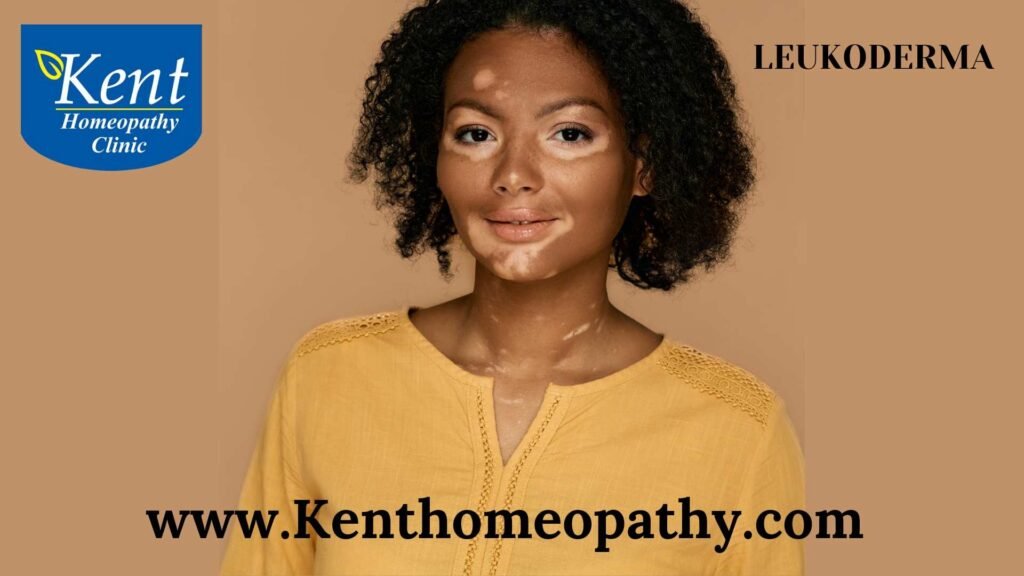Leukoderma

Leukoderma: Unraveling Symptoms, Causes, and Types
Leukoderma, also known as vitiligo, is a skin disorder characterized by the development of depigmented patches on the skin. These patches result from the loss of melanocytes, the pigment-producing cells in the skin. Understanding the symptoms, causes, and types of leukoderma is essential for accurate diagnosis and effective management.
Symptoms:
- Depigmented Patches: The primary symptom of leukoderma is the presence of depigmented or white patches on the skin. These patches can vary in size and shape and may gradually enlarge over time.
- Symmetrical Distribution: In many cases, leukoderma exhibits a symmetrical distribution, meaning that depigmented patches appear on both sides of the body in corresponding locations.
- Common Sites: Leukoderma often affects areas exposed to the sun, such as the face, hands, arms, feet, and areas around body openings like the eyes and mouth.
- Hair and Color Changes: In addition to skin depigmentation, individuals with leukoderma may experience a loss of color in the hair located within the affected patches, turning them white or gray.
- Koebner Phenomenon: Some people with leukoderma may experience the Koebner phenomenon, where new depigmented patches develop at sites of skin trauma, such as cuts, scratches, or burns.
- Eyelash and Eyebrow Involvement: Leukoderma can also affect the eyelashes and eyebrows, leading to depigmentation in these areas.
- Mucous Membrane Involvement: In rare cases, leukoderma may extend to involve the mucous membranes, leading to depigmented patches inside the mouth or on the genitalia.
- No Other Symptoms: Leukoderma typically does not cause other physical symptoms, such as itching or pain, but the cosmetic impact can significantly affect an individual’s emotional well-being.
Causes:
- Autoimmune Factors: One of the leading theories behind leukoderma is an autoimmune response, where the body’s immune system mistakenly attacks and destroys its own melanocytes. Genetic factors may contribute to this autoimmune response.
- Genetic Predisposition: There is a genetic component to leukoderma, with a higher risk in individuals with a family history of the condition. Certain genes associated with the immune system and melanocyte function may play a role.
- Neural Theory: Some researchers propose the neural theory, suggesting that biochemical substances released from nerve endings may be toxic to melanocytes, leading to their destruction and the development of depigmented patches.
- Oxidative Stress: Oxidative stress, caused by an imbalance between free radicals and antioxidants in the body, has been implicated in the development of leukoderma. This oxidative stress may contribute to the destruction of melanocytes.
- Viral Infections: Certain viral infections, such as herpes simplex, have been linked to the onset or exacerbation of leukoderma in some individuals. The exact mechanisms are not fully understood.
- Environmental Triggers: Exposure to certain environmental factors, such as chemicals or industrial pollutants, may trigger leukoderma in susceptible individuals.
- Hormonal Changes: Changes in hormonal levels, particularly during puberty or pregnancy, may influence the development or progression of leukoderma.
- Neurochemical Factors: Imbalances in neurochemicals, including neuropeptides, have been proposed as potential contributors to leukoderma.
- Psychological Stress: While stress is not a direct cause, it can potentially exacerbate leukoderma in individuals who already have the condition.
Types:
- Non-Segmental Vitiligo: This is the most common type of leukoderma, characterized by depigmented patches that are widespread and often symmetrical. Non-segmental vitiligo can further be classified into focal, mucosal, acrofacial, and generalized subtypes.
– Focal Vitiligo: Involves one or a few isolated depigmented patches.
– Mucosal Vitiligo: Affects mucous membranes, leading to depigmentation inside the mouth or on the genitalia.
– Acrofacial Vitiligo: Predominantly involves the face, hands, and feet.
– Generalized Vitiligo: The most common subtype, with widespread depigmentation on various parts of the body.
- Segmental Vitiligo: This type is characterized by depigmented patches that are localized to one side or segment of the body. Segmental vitiligo usually develops at an earlier age than non-segmental vitiligo.
- Mixed Vitiligo: Some individuals may have features of both non-segmental and segmental vitiligo, leading to a diagnosis of mixed vitiligo.
Contact to know more
Contact
Timings
Monday to Saturday:
11:00 AM to 02:30 PM
06:30 PM to 09:00 PM
